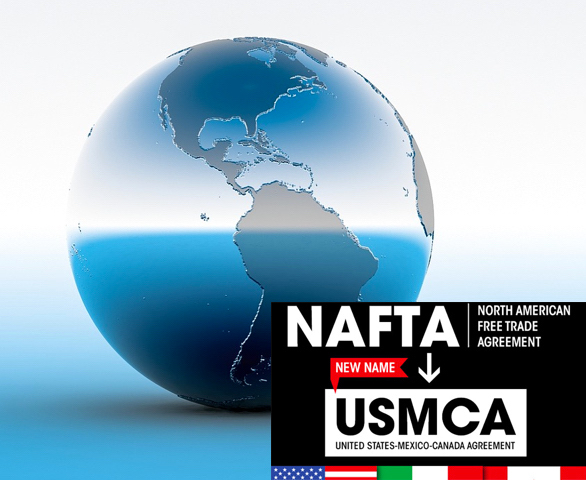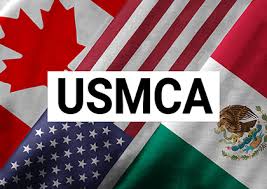Electronics Industry Joins Effort to Finalize New North American Trade Agreement
USMCA would impact more than a $1 trillion in trade between the US, Mexico, and Canada. Guidance on issues like IP protections and the automotive supply chain have high relevance to the electronics industry.

The electronics industry is joining those calling for a finalization of the US-Mexico-Trade Agreement, or USMCA. In February, the USMCA Coalition, a group of more than 200 companies and associations formed by the US Chamber of Commerce, formed to help secure congressional approval for the tentative trade agreement, which was signed by the leaders of the three North American countries on November 30, 2018. The electronics industry is represented by IPC – Association Connecting Electronics Industries and UL, and by numerous technology companies, including TE Connectivity, Cisco Systems, Microsoft, Samsung Electronics America, IBM, Flextronics International USA, and many others.
“Building a stronger US electronics industry depends in no small measure on building a stronger North American supply chain,” said IPC President and CEO John Mitchell. “Our association has members with both headquarters and thousands of jobs in the US, Mexico, and Canada, and thus we have a strong interest in securing enactment of this agreement.”
Much of USMCA remains consistent with the 25-year-old North American Trade Agreement (NAFTA), however, it includes several key provisions that recognize the transformative technology advancements made since the 1990s. Digital trade, e-commerce, and data location are addressed for the first time, as these industries didn’t exist when NAFTA was enacted.
They are addressed by the Comprehensive and Progressive Agreement for Trans-Pacific Partnership (CPTPP), which was signed in February 2016 by 11 countries, including Mexico and Canada. Those countries will be covered under both the CPTPP and USMCA. (The US withdrew from that agreement, which originated as the Trans-Pacific Trade Agreement during the previous administration.)
Technology Updates
Under USMCA, businesses that transmit digital information, including purchased digital products (e.g., software, music, videos, etc.), will be able to continue doing so across borders, without being subject to duties or other charges, and will not be required to establish local data centers.

Intellectual property protections are also addressed. Under USMCA, patent or copyright holders will enjoy copyright protection for 70 years after the death of the original copyright, an extension of 20 years beyond the protections currently in place.
A section of the agreement called Technological Protection Measures (Article 20.67) has special relevance for protection of IP for electronics companies, stating that, “No Party shall be obligated to require that the design of, or the design and selection of parts and components for, a consumer electronics, telecommunications, or computing product provide for a response to any particular technological measure.”
USMCA also establishes a Committee on IP Rights, which will include government officials from each country, who will “identify appropriate opportunities to increase cooperation between the Parties on trade-related intellectual property rights protection and enforcement.”
Automotive Impact
USMCA will have a sizable impact on the North American auto industry and in turn, on the associated electronics industry. The automotive market is the largest market for connectors, accounting for more than 23% of the world connector market, and more than 28% of the North American connector market per Bishop & Associates’ World Connector Market Handbook. As autonomous, electric, and fully connected vehicles expand their reach, this number is expected to significantly rise.
The new agreement’s Rule of Origin mandates that 75% of a vehicle’s components be manufactured in North America, an increase from NAFTA’s 62.5%. Companies that already have facilities in North America are well-positioned, and others are now incentivized to locate operations in the three member countries. It is expected that Mexico will benefit the most from new manufacturing investments, due to its lower wages. Former Mexican Minister of Economy Ildefonso Guajardo Villarreal has said that 70% of current vehicle production in Mexico already complies with USMCA requirements.
However, Mexico is more challenged than the US and Canada to meet new requirements that 40% of assembly workers make at least $16 an hour. The United Auto Workers (UAW) and American Federation of Workers and Congress of Industrialized Organizations (AFW-CIO) have expressed concerns that UMSCA lacks enforcement measures for these requirements and say that Mexico must reform its labor laws before the agreement goes into effect.
A survey of 100 US-based auto executives found that production costs would increase due to USMCA. To decrease costs, 36% plan to pass costs on to suppliers and 35% will find efficiencies in the production process.
In recognition of the rapid rate of technological change, USMCA will be subject to a joint review every six years and a 16-year sunset clause in which another review is required to extend the agreement.
 USMCA covers the vast array of cross-border trade, which significantly centers on the agricultural and automotive sectors. Since the implementation of NAFTA, trade between the three countries has increased from $290 billion in 1993 to more than $1.1 trillion in 2016, and trade between the US and its neighbors has tripled, according to a Council of Foreign Relations assessment of the economic impact of NAFTA. Positive trade relationships maintain lower consumer prices and contribute to higher productivity for all three member countries. Mexico and Canada are the two largest export markets for the US, and the deal is credited with increasing the US GDP by 0.05%, or up to $80 billion. However, it is also blamed for job losses, particularly in blue-collar areas such as auto assembly and manufacturing.
USMCA covers the vast array of cross-border trade, which significantly centers on the agricultural and automotive sectors. Since the implementation of NAFTA, trade between the three countries has increased from $290 billion in 1993 to more than $1.1 trillion in 2016, and trade between the US and its neighbors has tripled, according to a Council of Foreign Relations assessment of the economic impact of NAFTA. Positive trade relationships maintain lower consumer prices and contribute to higher productivity for all three member countries. Mexico and Canada are the two largest export markets for the US, and the deal is credited with increasing the US GDP by 0.05%, or up to $80 billion. However, it is also blamed for job losses, particularly in blue-collar areas such as auto assembly and manufacturing.
In mid-March, discussions began between US Trade representative Robert Lighthizer and Democrats in the House of Representatives to ease concerns about the agreement, which primarily center on labor, enforcement issues, and prescription drug prices. Lighthizer is thought to have a good relationship with the Democratic caucus and the White House is expecting USMCA to become ratified sometime in 2019. Until then, the possibility exists that the US will withdraw from NAFTA without another plan.
To see the complete text of USMCA, click here.
Like this article? Check out our other Industry Facts and Figures and Connector Industry News articles.
- Meet the Connector: DIN Standard Connectors - April 16, 2024
- Software-Driven Radio Reinvigorates Old Technology - April 9, 2024
- What is a Busbar? - April 2, 2024







